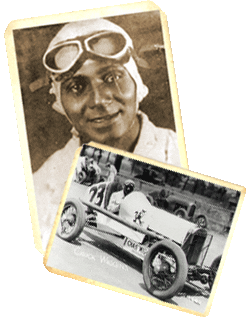Gold and Glory Sweepstakes Highlighted Black Racing

From Freetown Village
The roar and excitement of cars racing around the track at the Indianapolis Motor Speedway was alluring to many.
But Blacks were barred from participating. After being told no by the American Automobile Association - the sport’s governing body - multiple times, Black Americans created their own auto racing event.
It was called the Gold and Glory Sweepstakes and it was held annually by the Colored Speedway Association on the dirt oval track at the Indiana State Fairgrounds.
It was an event that drew Black elites from throughout the country. From 1924 to 1936, as many as 15,000 spectators attended the race each summer.
The 100-mile race included a grand prize of $2,500, and drew dozens of Black drivers to compete. But only 20 would participate in each race.
Indianapolis native Charlie Wiggins became the star of the race. He earned the nickname "Speed King" for winning the Gold and Glory Sweepstakes four times, driving a car he built from junk parts. The car ran on a special fuel of airplane fuel and castor oil.
Wiggins became known as The Negro Speed King”— more than six decades before Willie T. Ribbs would become the first Black driver to qualify for the Indianapolis 500 in 1991.
Wiggins lived to see one of his protégés, Sumner "Red" Oliver, become the first African American official mechanic in Indy 500 history as a member of the 1973 Patrick Racing Team.
Wiggins’ racing career ended in 1936 after a 13-car crash that resulted in the loss of his right leg and eye. Despite his injuries and constant pain, he continued to mentor promising young drivers, including some 500-Mile Race winners, and campaigned against segregation in the auto racing industry.
The Colored Speedway Association ceased to exist in 1936 with its biggest star gone as a result of the crippling accident and the onset of the Great Depression.
Freetown Village (freetown.org) is a living history museum with the mission to educate the public about African American lives, arts, and culture in Indiana through living history, exhibits, allied programs, and the collection and preservation of artifacts.
